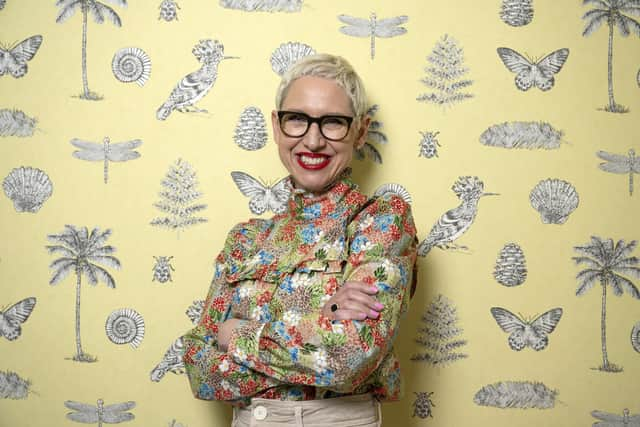Property interview: TV presenter Anna Campbell-Jones on Edinburgh’s Green Home Festival,
But, when I moved back to Glasgow, I was asked to help on a project to turn an office building into apartments. Designing for homes is very different. With commercial design, you have data that you can use to support your decisions, but with homes it is all about how something makes you feel.
At the same time, I was teaching a couple of days at the art school, and I then embarked on residential projects through word of mouth.
Advertisement
Hide AdAdvertisement
Hide AdIn 2006, I set up an interior design practice with an art school friend.


What prompted you to get involved with the Green Homes Festival?I am passionate about sustainability and have been for years. To have a platform because of my TV work, to talk about a subject I feel really strongly about is amazing – I really do have plenty to say.
And while I am aware that most interior designers would encourage clients to change things – that is how they make their living – I am in a privileged position that I can say we shouldn’t be buying new furniture and ripping out kitchens.
Your event at the festival focuses on kitchens, so how can they be made more eco-friendly? There are ways of creating a kitchen which will last a lifetime, that is not necessarily high-end, hand-built solid wood, which can cost tens of thousands.
For example, when it came to designing my own kitchen, I had absolutely no money, because when we bought the flat [in Glasgow] it was fire damaged, so all the budget went on rewiring and replumbing, with not a lot left over.
But I found someone locally to fabricate a worktop from stainless steel. Unlike other worktop materials, it will last for years because it is virtually indestructible. The appliances are all freestanding, so if they need to be replaced they can be without having to rip out the whole kitchen.
There are also lots of ways of buying someone else’s old kitchen. People take them out when they buy a new house, so there are opportunities for buying second-hand units for very little money.
And then there is going for an antique look – for instance, buying a Welsh dresser and freestanding units and working with what you have, using paint to freshen things.
Advertisement
Hide AdAdvertisement
Hide AdHow would you describe your design ideals? I don’t advocate that people follow fashion, but that doesn’t mean you have to make safe choices, because I really don’t like the idea of people designing their homes just with a future sale in mind.
If everything is completely beige, for instance, all you are really saying is that you are very worried about someone else’s opinion.
Your home is like your family’s biography – telling your story and who you are to people who come to visit.
How can we make changes to lessen our carbon footprint in other areas of the house? Always think twice before buying something new, and consider if you can work with something that you have already.
If you do buy something new, check its provenance and make sure that it is designed to last. Good furniture will last a long time if you look after it, and much of the stuff you find second-hand is a lot better made than you will find new in any shop – no matter what the price.
Why do you think Scotland’s Home of the Year has been so successful?I’d always seen interior design programmes as experts swanning into someone’s home and telling them what they were doing wrong and imposing their own ideas. That approach is exactly what I didn’t like in my consultancy work. I have always worked collaboratively with clients to bring out the look that they would achieve if they knew what I know, so it is very much a joint effort. That is where the reward comes for me.
So I wasn’t particularly interested in judging other people’s houses – Scotland’s Home of the Year is more about what home means rather than what it looks like, and I think that is where the warmth of the show comes from.
People really do understand that although we are called judges, we aren’t judgemental.
Advertisement
Hide AdAdvertisement
Hide AdWe finished filming [the next series] a couple of weeks ago, and I’m very excited about it. There is really good fun energy in the show between the three of us and lots of amazing homes. But you’ll have to wait until next spring before we can discuss it.
Anna’s event, Ingredients for a Greener Kitchen, will be held on Monday, 14 August at 11am, as part of the Green Home Festival in Edinburgh. To book tickets, go online and visit greenhomefestival.co.uk
Personal properties
Born and raised Born in Chiswick and brought up in Hammersmith in West London. I first moved to Scotland for university in 1989.
Study I studied a degree in interior design at the Glasgow School of Art, graduating in 1991.
Career When I graduated, I moved to London, working in commercial interior design. Ten years later I came back to Glasgow to bring up my children. I was asked to help with the conversion of a commercial building back to residential apartments and my interior design career grew by word of mouth. I started presenting Scotland’s Home of the Year in 2018.
Residence In Glasgow, in a main-door tenement flat.
Family My partner, Peter, is Irish and is head of housing and employability for West Dunbartonshire Council. I have two children, Frank, who is a design engineer at Linn Products, and Stan, who is at Edinburgh College of Art studying Film and TV.